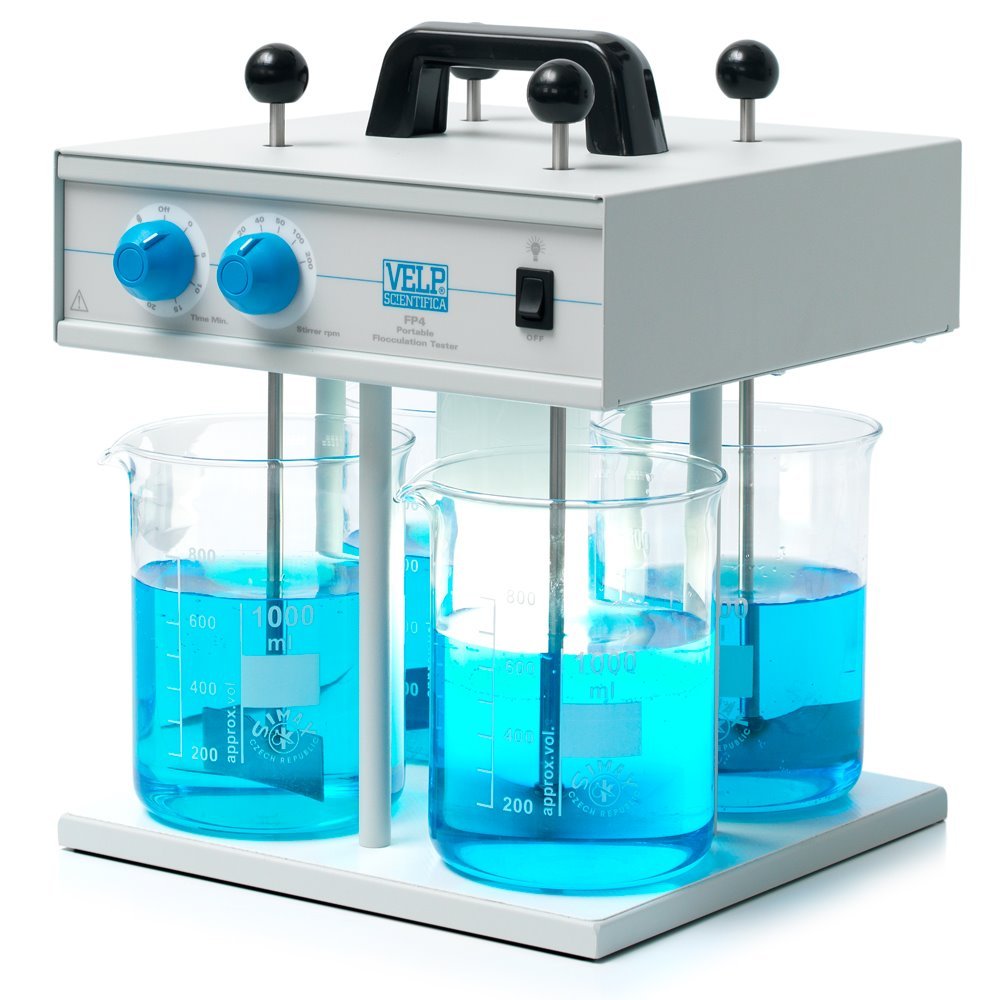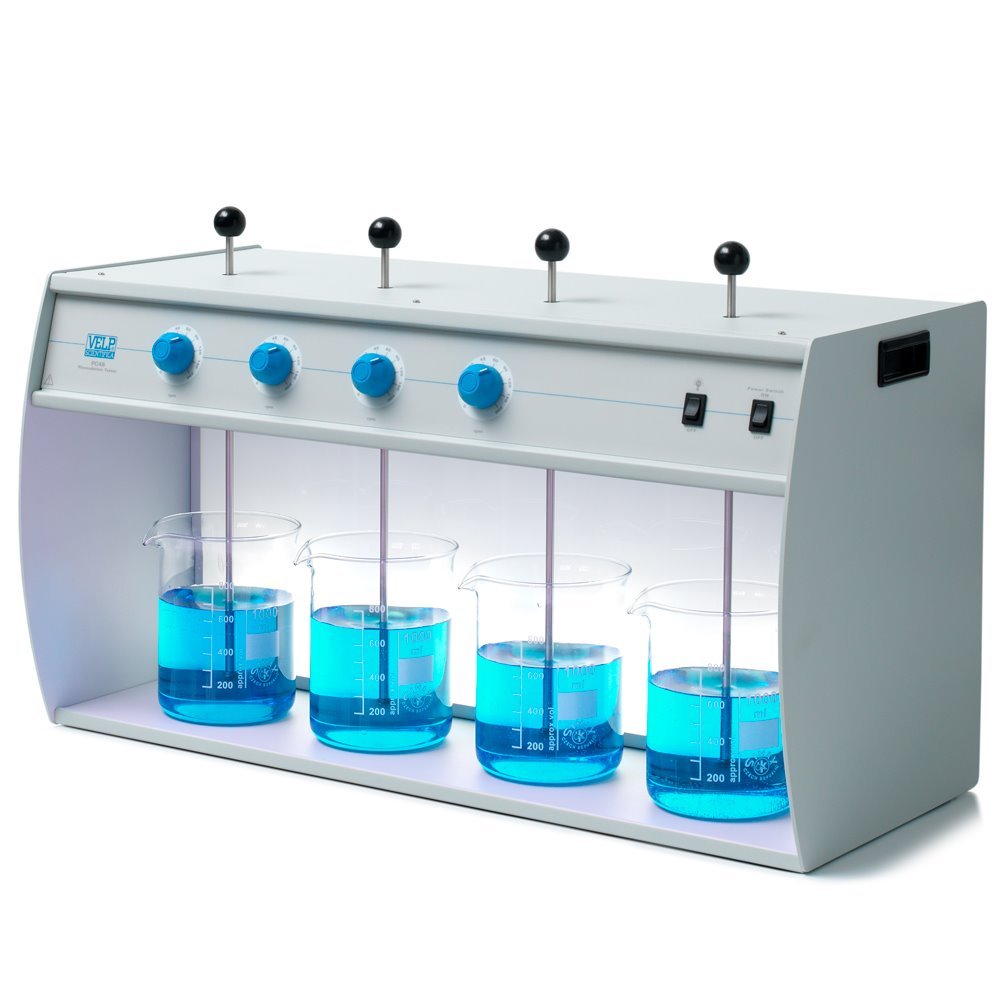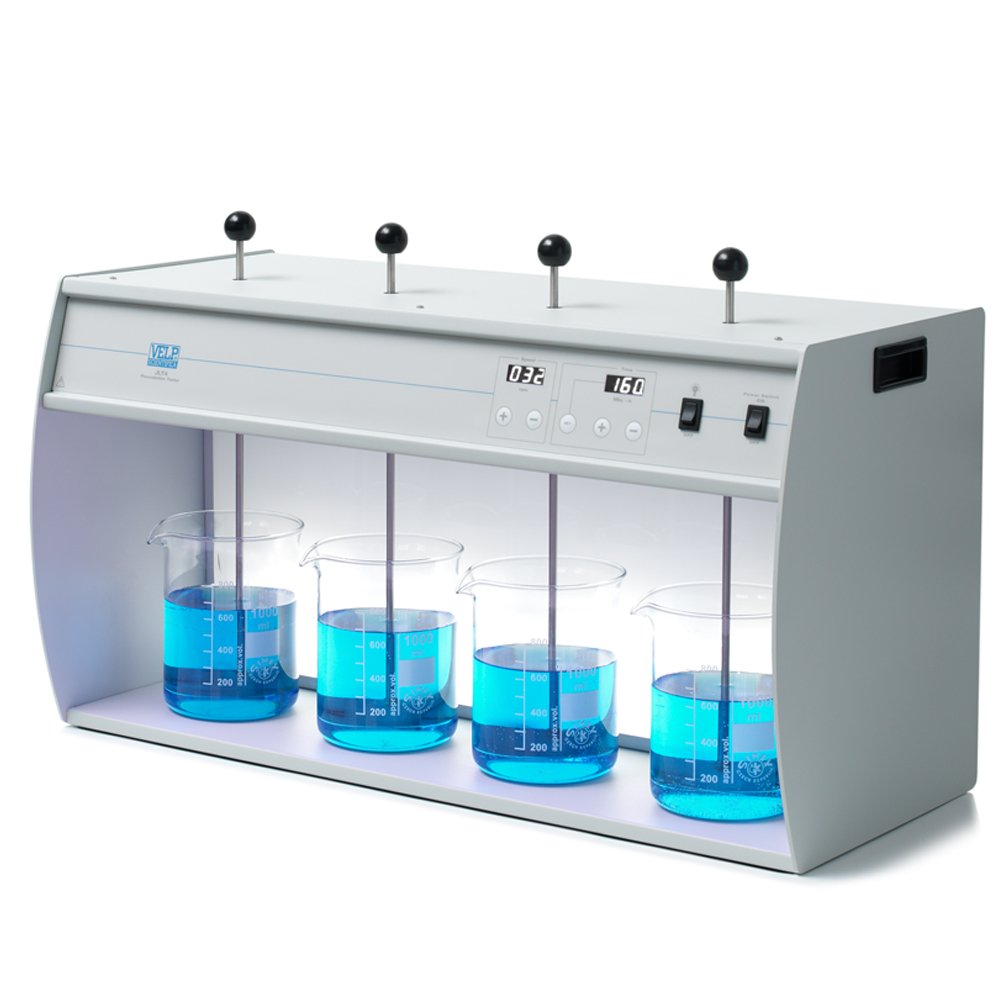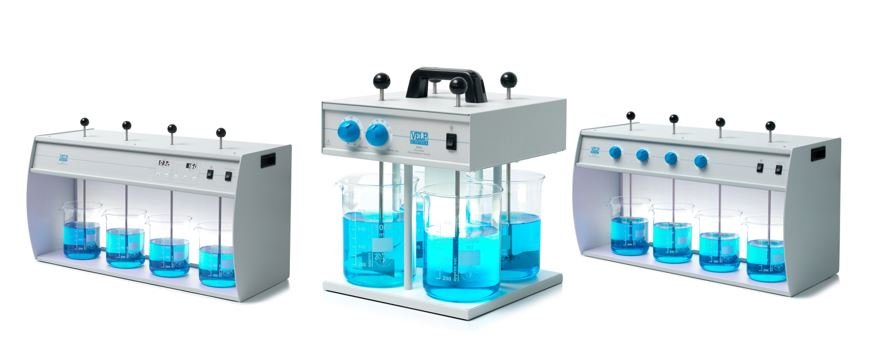Flocculators
FP4 Portable Flocculator

Portable flocculator that allows standard conditions to be adopted for Jar Test.
Practical and Reliable
- Designed to be used on-site for immediate results
- Powered by car cigarette lighter or plugged into the power grid
- Anti-skid base for stability
- Central light to facilitate reading
- Choice of 20-40-50-100-200 rpm stirring speeds
- Selectable operating time for unattended operation
- Reliable and repeatable results from VELP stirring quality
- Precise speed from an electronically controlled DC gear motor
- 4 samples can be processed in parallel
- Stirring rods adjustable in height without tools
- Strong resistance to chemical and mechanical corrosion.
What is JAR TEST?
Jar testing is a pilot-scale test of the treatment chemicals used in a particular water plant.
It simulates the coagulation/flocculation process in a water treatment plant, helping the operator in the determination of the right amount of treatment chemicals, and, thus, in improving the plant’s performance.
Jar testing entails adjusting the amount of chemicals and their sequence in which they are added. The sample requires to be stirred so that the formation, development, and settlement of floc can be watched just as it would be in the fullscale treatment plant.
The operator then performs a series of tests to compare the effects of different amounts of flocculation agents at different pH values to determine the right size floc.
| CONSTRUCTION MATERIAL: | Epoxy painted metal structure |
| STAINLESS STEEL STIRRING RODS: | adjustable in height by a self blocking chuck |
| MONOSELECTOR: | same speed for each rod |
| NUMBER OF STIRRING RODS: | 4 |
| POWER: | 6 W |
| POWER SUPPLY: | 100 – 240 V / 50-60 Hz |
| WEIGHT: | 4,8 Kg (10.6 lb) |
| DIMENSIONS (WXHXD) : | 250x320x250 mm (9.8×12.6×9.8 in) |
| TIMER: | from 0 to 30 minutes (or continuous) |
| ELECTRONIC SPEED CONTROL: | 20 – 40 – 50 – 100 – 200 rpm |
FC S Series Flocculators with Independent Positions

Flocculators with 4 or 6 independent positions that allow standard conditions to be adopted for Jar Test.
Precise and Easy to use
- Speed can be changed during the run
- Illuminated back panel to simplify sample observation
- Stirring rods adjustable in height without tools
- Reliable and repeatable results from VELP stirring quality
- Precise speed from an electronically controlled DC gear motor
- Strong resistance to chemical and mechanical corrosion
- Independently selectable speeds 10-15-30-45-60-90-120-150-200-300 rpm
- Same product can be submitted to different conditions in parallel
- Choice of 4- or 6-place models.
What is JAR TEST?
Jar testing is a pilot-scale test of the treatment chemicals used in a particular water plant.
It simulates the coagulation/flocculation process in a water treatment plant, helping the operator in the determination of the right amount of treatment chemicals, and, thus, in improving the plant’s performance.
Jar testing entails adjusting the amount of chemicals and their sequence in which they are added. The sample requires to be stirred so that the formation, development, and settlement of floc can be watched just as it would be in the fullscale treatment plant.
The operator then performs a series of tests to compare the effects of different amounts of flocculation agents at different pH values to determine the right size floc.
CONSTRUCTION MATERIAL: epoxy painted metal structure MODELS: FC4S 4 positions
FC6S 6 positionsBACK PANEL: disconnectable illuminated STAINLESS STEEL STIRRING RODS: adjustable in height by a self blocking chuck PLURISELECTOR: settable individual speed for each rod POWER: FC4S 18 W
FC6S 23 WWEIGHT: FC4S 12.5 kg (27.5 lb)
FC6S 18 kg (39.6 lb)DIMENSIONS (WXHXD): FC4S 645x347x260 mm (25.4×13.7×10.2 in)
FC6S 935x347x260 mm (36.8×13.7×10.2 in)SPEED SELECTOR SETTABLE AT: 10 – 15 – 30 – 45 – 60 – 90 -120 – 150 – 200 – 300 rpm
JLT Series Flocculators

Digital Flocculators in 4 and 6 positions with timer and illuminated back panel to allow standard conditions to be met during Jar Testing.
Easy to use and Reliable
- Microprocessor controlled operating time for unattended operation
- Illuminated back panel simplifies the observation of the samples
- Stirring rods adjustable in height without tools
- Digitally selectable speed from 10 to 300 rpm
- Identical speed and time for all positions for comparable results
- Reliable and repeatable results from VELP stirring quality
- Precise speed from an electronically controlled DC gear motor
- Strong resistance to chemical and mechanical corrosion
- High visibility LED displays for speed and time
- Choice of 4- or 6-place models
What is JAR TEST?
Jar testing is a pilot-scale test of the treatment chemicals used in a particular water plant.
It simulates the coagulation/flocculation process in a water treatment plant, helping the operator in the determination of the right amount of treatment chemicals, and, thus, in improving the plant’s performance.
Jar testing entails adjusting the amount of chemicals and their sequence in which they are added. The sample requires to be stirred so that the formation, development, and settlement of floc can be watched just as it would be in the fullscale treatment plant.
The operator then performs a series of tests to compare the effects of different amounts of flocculation agents at different pH values to determine the right size floc.
| CONSTRUCTION MATERIAL: | epoxy painted metal structure |
| MODELS: | JLT 4 4 positions JLT 6 6 positions |
| BACK PANEL: | disconnectable illuminated |
| STAINLESS STEEL STIRRING RODS: | adjustable in height by a selfblocking chuck |
| MONOSELECTOR: | same speed for each rod |
| POWER: | JLT 4 11 W JLT 6 19 W |
| DIMENSIONS (WXHXD): | JLT 4 645x347x260 mm (25.4×13.7×10.2 in) JLT 6 935x347x260 mm (36.8×13.7×10.2 in) |
| WEIGHT | JLT 4 13 kg (28.6 lb) JLT 6 17 kg (37.4 lb) |
| ELECTRONIC SPEED CONTROL: | from 10 to 300 rpm |
| SPEED SETTING INTERVAL: | 1 rpm |
| MICROPROCESSOR CONTROLLED TIMER: | 0÷999 min or 0 ÷99 hours (or continuous) |
